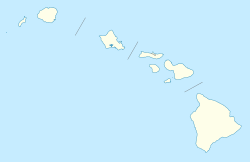Chinatown, Honolulu facts for kids
Quick facts for kids |
|
|
Chinatown Historic District
|
|

Historic Wo Fat restaurant building (built 1938), at the corner of Hotel and Maunakea
|
|
| Location | Beretania Street, Nuuanu Stream, Nuuanu Avenue, and Honolulu Harbor, Honolulu, Hawaii |
|---|---|
| Area | 36 acres (15 ha) |
| Built | 1900 |
| NRHP reference No. | 73000658 |
| Added to NRHP | January 17, 1973 |
The Chinatown Historic District is a special neighborhood in Honolulu, Hawaii. It's famous for its vibrant Chinese American community. This district is one of the oldest Chinatowns in the entire United States. It's a place rich in history and culture, showing how Chinese immigrants helped shape Hawaii.
Contents
Exploring Chinatown's Location
Chinatown is located in downtown Honolulu. Its exact borders can be a bit tricky to define! Generally, the Honolulu Harbor forms its western edge. The Nuʻuanu Stream is usually seen as the northern boundary. To the east, you'll find Beretania Street, and Nuʻuanu Avenue is often the southern border.
Some people think Chinatown stretches a bit further south along Merchant Street. In total, this historic area covers about 36 acres. Close by, you can find the Hawaii Capital Historic District and the Merchant Street Historic District.
Landmarks and Special Spots
As you explore Chinatown, you'll notice some unique features. Since 2002, there are two small paifang (traditional Chinese archways) on North King Street. These beautiful arches welcome you to the area.
You can also find a small brick entrance arch to the Maunakea Marketplace. It has a green-tiled roof, making it stand out. At the southern entrance to Chinatown on Hotel Street, you'll see two guardian lions. These lions were a gift from Kaohsiung, a sister city in Taiwan, in 1989. They stand near the Dr. Sun Yat-sen Memorial Park. Dr. Sun Yat-sen was a very important Chinese leader.
Historic Buildings
One of the most famous buildings was the Wo Fat Restaurant. It was Honolulu's oldest restaurant, first opening in 1882. The original building was destroyed in a fire. A new one was built in 1901, and the current three-story building opened in 1938. The restaurant closed in 2005.
Another important spot is the Oahu Market, which opened in 1904. It's located at the corner of King and Kekaulike streets. This market is a large, open-air space with many stalls. It's still used today for selling fresh fish and local produce, just as it was over a hundred years ago!
Chinatown's Rich History
The area where Chinatown now stands has a long history. It was likely used by fishermen in ancient Hawaii. Later, in the late 1700s, Kealiimaikai, the brother of King Kamehameha I, lived here.
Some of the first non-Hawaiian settlers also made their homes here. Isaac Davis, an advisor, lived in the area until 1810. A Spaniard named Don Francisco de Paula Marín lived in the southern part of the area in the early 1800s. He even planted a vineyard in the northern part, which is why Vineyard Boulevard is named that way today.
Chinese Immigrants and Growth
During the 1800s, many laborers came from China to work on sugar plantations in Hawaii. After their work contracts ended, many of them became merchants. They moved to this area, which then became known as Chinatown. While the neighborhood has always been home to many different groups, Chinese people made up about 56% of the population in 1900. Honolulu is traditionally known in Chinese as 檀香山 (Tánxiāngshān), meaning Sandalwood Mountain.
The Great Fires
Chinatown faced two major fires that destroyed many buildings. The first was in 1886. The second, and much larger, fire happened in 1900. This fire started when officials tried to burn down a building that was thought to have a serious illness. Unfortunately, the fire got out of control on January 20, 1900, due to shifting winds. It ended up destroying most of the neighborhood.
After the 1900 fire, many new buildings were constructed. Most of these buildings date from 1901 and are not very tall, usually four stories or less. These buildings give Chinatown its unique historic look today.


